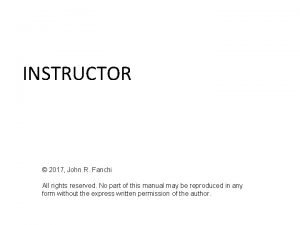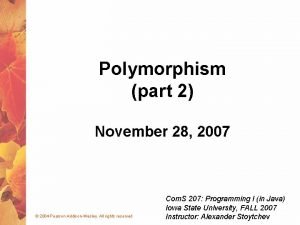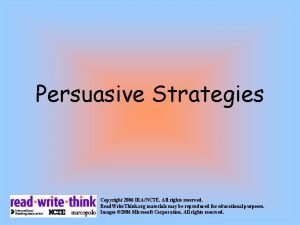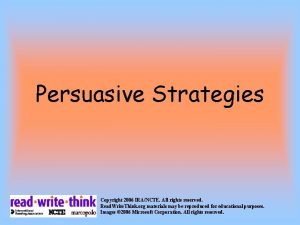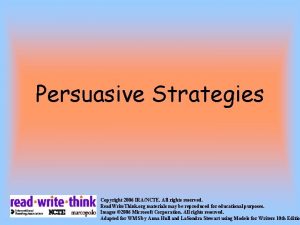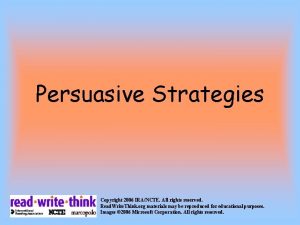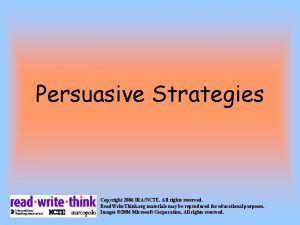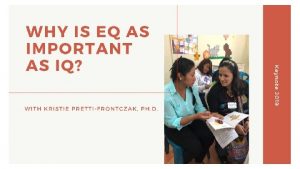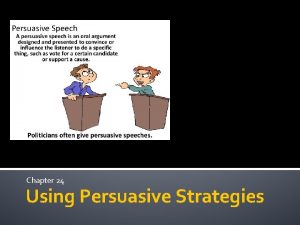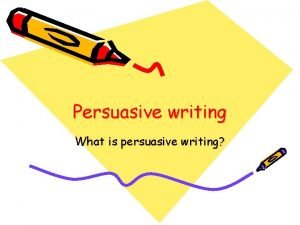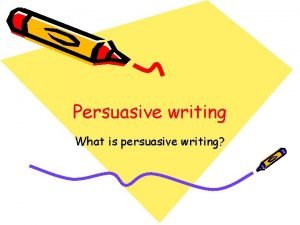Persuasive Strategies Copyright 2006 IRANCTE All rights reserved





























- Slides: 29

Persuasive Strategies Copyright 2006 IRA/NCTE. All rights reserved. Read. Write. Think. org materials may be reproduced for educational purposes. Images © 2006 Microsoft Corporation. All rights reserved.

Claim State your argument. Example: I am going to try to convince you that chocolate is a healthy snack.

Big Names Important people or experts can make your argument seem more convincing. Example: Former U. S. president Bill Clinton thinks that junk food should be taken out of vending machines.

Logos Facts, numbers, and information can be very convincing. Example: A Snickers bar has 280 calories and 30 grams of sugar. That’s not very healthy.

Pathos Getting people to feel happy, sad, or angry can help your argument. Example: Your donation might just get this puppy off the street and into a good home.

Ethos If people believe and trust in you, you’re more likely to persuade them. Example: Believe me! I’ve been there before. I’m just like you.

Kairos Try to convince your audience that this issue is so important they must act now. Example: This is a one-time offer. You can’t get this price after today.

Research Using reliable research can help your argument seem convincing. Example: A recent study found that students who watch TV during the week don’t do as well in school.

Some commonly used features of PERSUASIVE TEXT • • • Emotive language – to get a sympathetic reaction. Imperatives (commands) – telling the reader what to do. Short sentences – dramatic effect. Logical connectives – e. g. ‘therefore’, ‘because’. Alliteration Address reader directly. Personal and informal tone. Use of contrasts to emphasize particular points. Use of facts to shock the reader.

PROPOGANDA • technique that attempts to influence the opinions, emotions, attitudes, or behavior of a group in order to benefit the sponsor • a specific type of message presentation aimed at serving an agenda • PURPOSE: appeal to one’s emotions

Characteristics of Propaganda • In advertising the purpose is to claim “superiority” in order to sell product. • Weasel Words: tackles, comforts, refreshes, fights, helps, virtually… (modifiers that look substantial but are meaningless) • Makes audience believe in something or want to do something.

To protect yourself against propoganda, ask yourself 1. Who does this benefit? 2. Why did they do that? 3. According to whom?

PROPOGANDA TECHNIQUES we’re going to focus on: • • • Name-calling Glittering Generality Transfer Testimonial Plain Folk Card-Stacking Bandwagon Slogan Snob Appeal

#1: Name-calling • Trash-talking about another product or person • "mudslinging” • Examples: Senator Hillary Clinton calling President Bush a “turd” on Ellen De. Generes Show You’re a turd, George !

#2: Glittering Generality • Words of praise for a product or person; using nice words like goodness or patriotism. • Examples: Mc. Donald’s is America’s favorite restaurant. • appeal to such notions as honor, glory, love of country, desire for peace, freedom, and family values. • It cannot be proved true or false because it really says little or nothing at all. FORD…built American tough

#3: Transfer Techniques • Using a strong symbol or phrase • arouses the audience’s emotions so that they’ll connect-transfer-the emotion to the product being sold • Propagandists often employ symbols (e. g. , waving the American flag) to stir our emotions and win our approval, sex appeal, wealth, power, fame. • Example: a political activist closes her speech with a prayer (to gain support at Baptist Convention)

#4: Testimonial • An important person or famous figure endorses a product. • using the words of a famous person to persuade you. • Examples: an athlete appears on the Wheaties box; Denzel Washington actor at Democratic National Convention; Tiger Woods and Nike

Like a good neighbor, State Farm is there. #5: Plain Folk • Appealing to regular people's values like family, patriotism • Examples: Senator Barack Obama eats at small business restaurants; Oprah Winfrey is photographed shopping for groceries • Example: Ken Nugent commercials “One Call, That’s All” One call, that’s all.

#6: Card-stacking 1990’s fried chicken was better than KFC. • Manipulating information to make a product appear better than it is often by unfair comparison or omitting facts. • Example: 1990 s Hardee’s chicken commercial stated their fried chicken was better than KFC.

#7: Bandwagon • • This technique tries to persuade everyone to join in and do the same thing. persuading people to do something by letting them know others are doing it. “everyone else is doing it, and so should you. ” Examples: an ad states that “everyone is rushing down to their Ford dealer to buy red Mustang convertibles”; “Don’t be left out”; “For only 2 days, …”

#8: Slogan • • • A catchword or phrase loaded with emotion Often sells through repetition Clever and easy to remember Stays with you a long time Often a melody you already know “Trust Sleepy’s For the ‘rest’ of your life”.


#9: Snob appeal • qualities in a product that appeal to the snobbery (wanting to be like those who are superior in society) in a purchaser 1957

Ambiguity • it is more difficult to interpret the meanings of particular ads

What does an OREO cookie have to do with persuasive writing?

How are things going with your writing? • • Have you met the standard? Have you engaged the reader? Have you stated a clear position? Have you supported your position with well articulated relevant evidence? Have you excluded all irrelevant arguments? Is your writing organized appropriately for your audience? Have you addressed your reader’s concerns and anticipated your counterargument? Have you provided closure?

Are you still curious about the OREO?

State your P I O N. Give your E A S O N S And your V I D E N C E. IT’S A EASY AS 1 -2 -3. 1. State your OPINION 2. Give your REASONS and your EVIDENCE. 3. Restate your OPNION in a different way. Then, restate your P I O N In a different way.

You can eat your cookie now.
 Copyright 2015 all rights reserved
Copyright 2015 all rights reserved Copyright © 2015 all rights reserved
Copyright © 2015 all rights reserved Dell all rights reserved copyright 2009
Dell all rights reserved copyright 2009 Copyright © 2018 all rights reserved
Copyright © 2018 all rights reserved All rights reserved example
All rights reserved example All rights reserved sentence
All rights reserved sentence Freesound content licence
Freesound content licence Confidential all rights reserved
Confidential all rights reserved All rights reserved example
All rights reserved example Pearson education inc all rights reserved
Pearson education inc all rights reserved Microsoft corporation. all rights reserved.
Microsoft corporation. all rights reserved. Microsoft corporation. all rights reserved.
Microsoft corporation. all rights reserved. Microsoft corporation. all rights reserved
Microsoft corporation. all rights reserved Pearson education inc. all rights reserved
Pearson education inc. all rights reserved Warning all rights reserved
Warning all rights reserved Siprop
Siprop Quadratic equation cengage
Quadratic equation cengage Warning all rights reserved
Warning all rights reserved Confidential all rights reserved
Confidential all rights reserved Microsoft corporation. all rights reserved
Microsoft corporation. all rights reserved 2010 pearson education inc
2010 pearson education inc Gssllc
Gssllc Pearson education inc all rights reserved
Pearson education inc all rights reserved Pearson education inc. all rights reserved
Pearson education inc. all rights reserved Confidential all rights reserved
Confidential all rights reserved Airbus deutschland gmbh
Airbus deutschland gmbh R rights reserved
R rights reserved Rights reserved
Rights reserved Copyright 2006
Copyright 2006 Copyright 2006
Copyright 2006


























